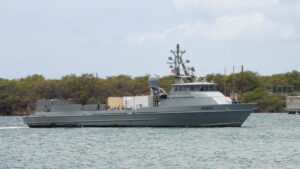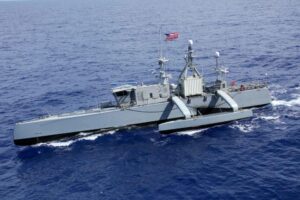The Navy’s experimentation with unmanned surface vessels (USVs) during the biennial Rim of the Pacific 2022 exercise is helping it shape the future of unmanned surface vehicles (USVs), service officials said last week.
RIMPAC prototyping and experimentation “is a significant event. Allowing us, with the fleet…to explore [concepts of operations] with fleet, maturation, and sustainment. Just as importantly is the feedback loop to our office and engineers and scientists as part of the scientific method,” Rear Adm. Casey Moton, Program Executive Officer for Unmanned and Small Combatants, told reporters during a virtual event Aug. 1.

Four Navy prototype Medium USVs (MUSVs) participated in RIMPAC at the same time in this exercise: the Medium USVs Sea Hunter and Seahawk, and the Ghost Fleet Overlord USVs Nomad and Ranger.
The former was first developed by the Defense Advanced Research Projects Agency and the Overlord ships were developed by the Pentagon’s Strategic Capabilities Office, but all of them fall under Surface Development Squadron One (SURFDEVRON One) in San Diego.
The Navy previously established Unmanned Surface Vessel Division One (USDIV1) as an Echelon V commander under SURFDEVRON One to help develop the vessels’ concepts of operations.
Moton said that events like RIMPAC allows the Navy to explore requirements and help determine how many of what they want to buy.
“Experimentation is helping us build trust with the fleet. Operating vessels, operating machinery plants, autonomy,” Moton said.
Brian Fitzpatrick, the principle assistant program manager for USVs at the unmanned maritime systems program office, PMS 406, explained that while this is not the first time the Navy has teamed manned vessels with these USVs, it’s the first time all four were used at the same time like this.
“It puts a different level of stress on it because now I don’t just have one USV and a whole dedicated engineering staff just for that and fleet operators…but it puts a level of stress on not just the systems but on the support behind it. It’s not everyone is focused on one thing, There’s four different things going on at one time, it’s a lot of the same people so you can’t just be behind it, you’re not going to be able to exercise at that level if you’re not ready,” Fitzpatrick said.
During the RIMPAC exercises, the Navy paired the Sea Hunter and Seahawk each with a separate destroyer, while the Nomad and Ranger were controlled from the Navy’s Unmanned Operations Center (UOC) at Naval Base San Diego.
Capt. Scot Searles, program manager for unmanned maritime systems, PMS-406, said that while the RIMPAC helped add more lessons on how USVs will be used in the fleet, this time they had to demonstrate how they can adjust control in real time because one of the destroyers had to drop out in the middle of the exercise.
“We saw one of DDGs had to drop out so they shifted control of the USVs. In addition to all the acquisition things we’re learning, we’re seeing lots of great learning opportunities on the fleet side of things on their employment and concept of operations,” Searles said.
Fitzpatrick said they could not specifically say why the ship had to back out, but “we were able to immediately switch back to the UOC in San Diego. So now we didn’t get the feedback directly from the destroyer, but…we had done this before so it’s not the first time in terms of switching.”
He said the Navy had previously practiced switching control platforms in the middle of a mission like this and “from the technical side, it was pretty seamless.”

All the officials argued the exercise is part of the Navy’s efforts to scale up its unmanned vessel operations, especially in relation to the Chief of Naval Operations’ (CNO) Navigation Plan and how he is planning for the service to look by 2045.
“We’ve got to start prototyping how we scale as well, and that’s one of the things we did with this RIMPAC exercise, scaling up our ability to operate, the fleet’s ability to operate multiple platforms. We’ve got to take the lessons learned from that and roll those in on our plans to scale the operations as well,” Searles said.
Fitzpatrick also clarified the concepts of operations will go beyond one USV per manned surface vessel, even if they did not yet practice that at RIMPAC.
“That’s a scaling point that we didn’t do at RIMPAC, we had one USV assigned to one surface combatant but we’re going to continue to grow that in future exercises – multiple USVs with one surface combatants and then multiple USVs with multiple surface combatants, two and two or two and three, those are things in the future CONOPS we’ve identified you need to go do, so we’re going to do it. Again, steps to scale to get where we need to get to.”
Moton underscored this kind of experimentation will also help the Navy start the program of record for large USVs (LUSVs) in fiscal year (FY) 2025. He reiterated the Navy’s FY ‘23 budget request assumes the service will only procure the first LUSV in FY ‘25.
“In terms of achieving that plan, we are maturing all of the systems engineering pillars to get to the level of maturity and we will achieve certification which will include senior technical authority, looking at our key technology areas, has the specific requirements for land based testing, for machinery plan in particular, and others technical areas. At its most fundamental level, the program office is using that as a piece of its plan to get to those certification points and that transition to LUSV.”
Moton noted the LUSV program of record is not just the design of these vessels but also sustainment plans, which were informed by this exercise.
“Even though these may be smaller than LUSV in most areas, certainly in autonomy development and control and sensory perception, you may have a different sensor suite, but almost all of it is transferable whether it’s LUSV or MUSV size.”
Moton also reiterated the Navy is only building one MUSV without future vehicles programmed in the FY ‘23 budget request, but this RIMPAC experimentation is informing future work on it regardless of what sizes are eventually chosen for the service.
“I think we will, whether or not we will buy more MUSVs, will be informed by what we’re learning at RIMPAC. When we decide that will be when we’re ready to decide. I think even the CNO has commented on this discussion publicly about what’s the best path on MUSVs or smaller USVs or those kinds of things, which I believe is a healthy conversation.
In April, CNO Adm. Mike Gilday said he was unsure whether the Navy will ultimately need a MUSV and the service will be in a better position with LUSV development by 2030 (Defense Daily, April 28).
The Navy previously said it is looking into using MUSVs for distributed low cost forward sensors and command and control nodes while LUSVs can be used as a distributed weapons payload capacity.
“I think this discussion is perfectly healthy as the CNO excellently framed,” Moton said.